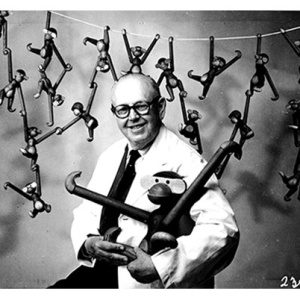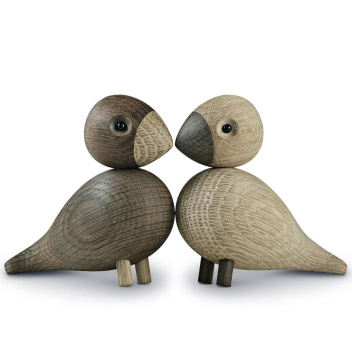Komplet drewnianych ptaszków H9 cm LOVEBIRDS 1 PAIR - Oak-Smoked Oak
Kay Bojesen559,00 zł brutto
KB-6896
Give a gift that will last a lifetime. Kay Bojesen's universe of wooden toys has just added more than songbirds to its family. These love birds only have eyes for each other as they stand there beak to beak. Decorative on a desk or window sill, they are a little reminder of love. This infatuated couple is a perfect gift idea for weddings and any fan of Danish design.
| Głęb.Szer.W | Height 9 cm Width 9.50 cm Depth 5 cm |
| Motyw | Zwierzęta, Ptaki, Owady, Ryby |
| Materiał | Drewno |
| Kolor | Dąb |
Ten produkt nie występuje już w magazynie.
Produkt na zamówienie, ok. 28 dni roboczych
Give a gift that will last a lifetime. Kay Bojesen's universe of wooden toys has just added more than songbirds to its family. These love birds only have eyes for each other as they stand there beak to beak. Decorative on a desk or window sill, they are a little reminder of love. This infatuated couple is a perfect gift idea for weddings and any fan of Danish design.
Kay Bojesen is famous for his wooden figures but it is widely unknown that Kay Bojesen was in fact a silversmith. He started his career as a silversmith with Georg Jensen and has designed both jewellery, cutlery and silverware. Interest in wood was sparked after the birth of his son Otto. This inspired his fascination with children's play and most importantly wooden toys.
Kay Bojesen began experimenting with wooden materials and soon he had created a series of wooden animals that would inspire children through play. For Kay Bojesen, it was important that the animals were not very realistic in order to trigger children's imagination. For this reason, his motto was "the lines should laugh".
Kay Bojesen is considered one of Denmark's foremost designers and when he died at the age of 72, he left a big legacy behind. A legacy of design icons like the classic wood pan, zebra, puffin and the pair of doves ‘Lovebirds’.
About the designer:
Kay Bojesen graduated as a silversmith in 1910 after completing his studies with silversmith Georg Jensen. He was one of the first Danish craftsmen to embrace functionalism. He was one of the pioneers who organized the Den Permanente association - an artists' cooperative that included a shop and exhibition space that over the decades came to represent the best in Danish and Scandinavian design. 1919 was the beginning of a new era for Kay Bojesen.
He married and his son Otto was born. This sparked Kay Bojesen's imagination and fascination with children, toys and wood and brought back memories of his own childhood when his father (the publisher Ernst Bojesen - the publisher of the Danish satirical annual Blæksprutten (The Octopus)) carved wooden figures for him and him encouraged his children to be creative, imaginative and playful.
The Bojesen family’s terrace in Bellavista was full of flowers, cane furniture... and birds, and at some point a picture of the wooden songbird was found in one of the family’s photo albums, which might well have been inspired by his flying friends on the terrace. It turned out later that there were originally five birds, and since then the family of songbirds has grown big and colourful.
All Kay Bojesen’s sweet songbirds spread joy and capture the hearts of both young and old with their charming personality. The Nightingale was created in collaboration with the new H.C. Andersen House, which opened in the summer of 2021, and is inspired by the world-famous author’s fairy tale about the little bird with the big voice. And the colours of the Nightingale are inspired by the beautiful Chinese Nightingale.
The bird Georg fuses Kay Bojesen’s use of both wood and silver, as both the beak and the legs are decorated with silver leaf. And the gorgeous shades of green in the plumage are inspired by Kay Bojesen’s jewellery with jade stones. The Alfred Bird is named after one of Kay Bojesen’s great-grandchildren. This Nordic name also symbolises the innocence and peace that has always characterised the designer’s wooden figures. The songbird Ruth is named after Kay Bojesen’s Swedish daughter-in-law. She took the family by storm with her femininity and love of pink.
The Sunshine bird represents one of the five original colour combinations. Originally designed in the 1950s, and like its five colourful siblings, it has never been produced before. The Raven songbird is crafted with black feather splendour and is a stylish and classic feature of the otherwise colourful bird collection from Kay Bojesen.
The series also includes the Kay songbird, named after Mr Bojesen himself who was a big fan of the colour blue. He was always wearing either an impeccable blue suit, shirt and tie or white work coat. And the Ernst songbird takes us one place up in the family tree to Kay Bojesen’s father – a gentleman with many talents. He was a businessman, publishing director, cultural personality and also a creative soul who, together with his wife Valborg, inspired his son Kay to create his collection of beloved wooden figures.
The birds series also features Kay Bojesen’s iconic turtle doves in several versions and his sparrows, which he designed in the mid-1930s. These birds bring a touch of romance into the imaginative world of Wooden Figures. Kay Bojesen’s songbirds are a good example of how he, with a simple design, managed to gives his figures life and soul, so that to this day they spark our imagination and speak to the child in all of us, across age and generations.

Kay Bojesen
Kay Bojesen graduated as a silversmith in 1910 after completing his apprenticeship with silversmith Georg Jensen. As one of the first Danish artisans to do so, he embraced functionalism.
Więcej


















